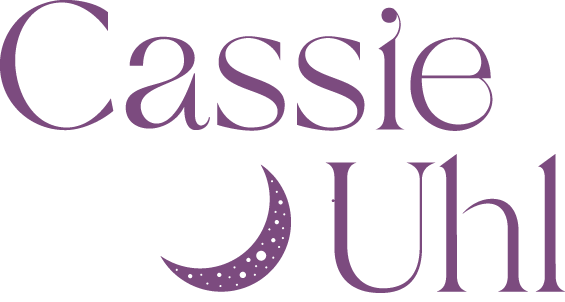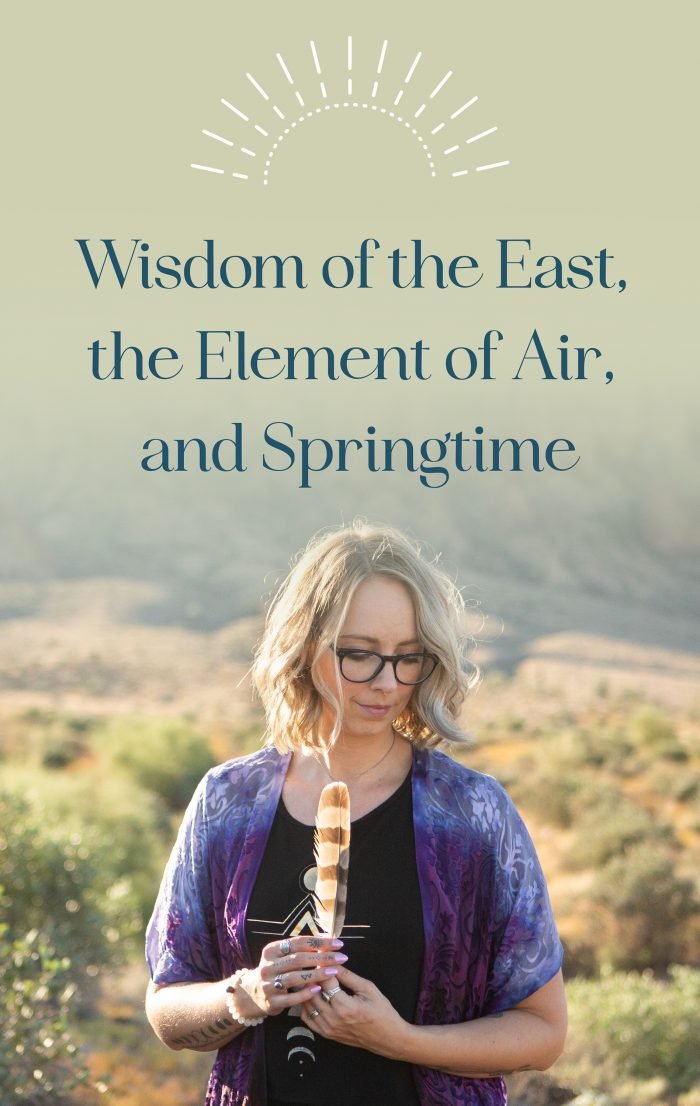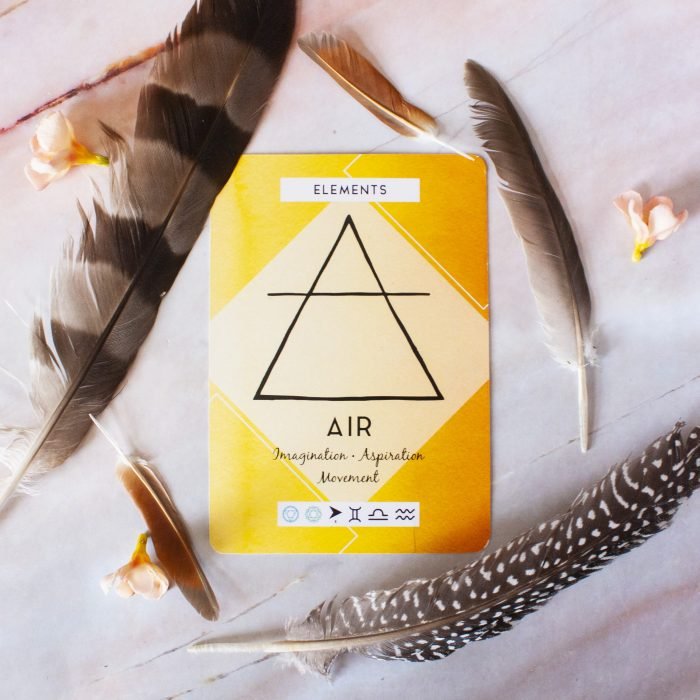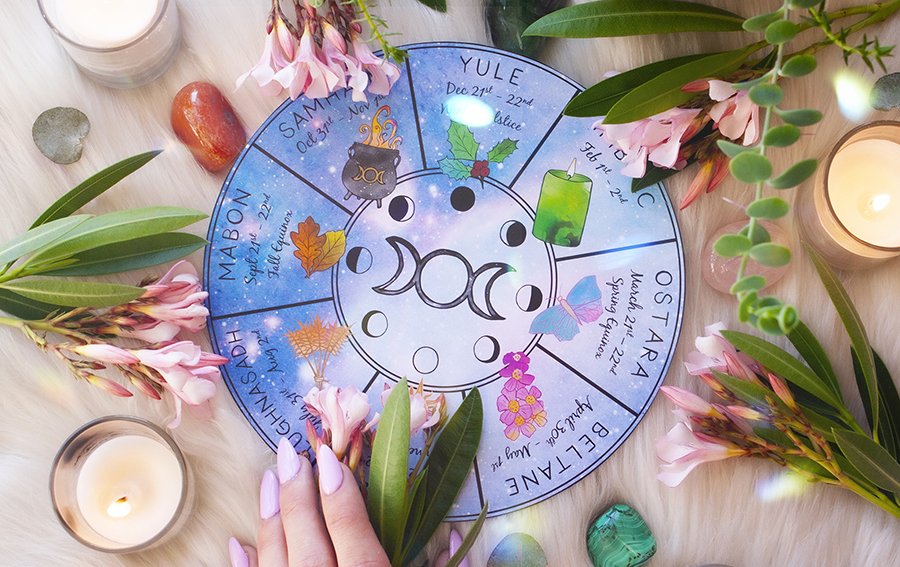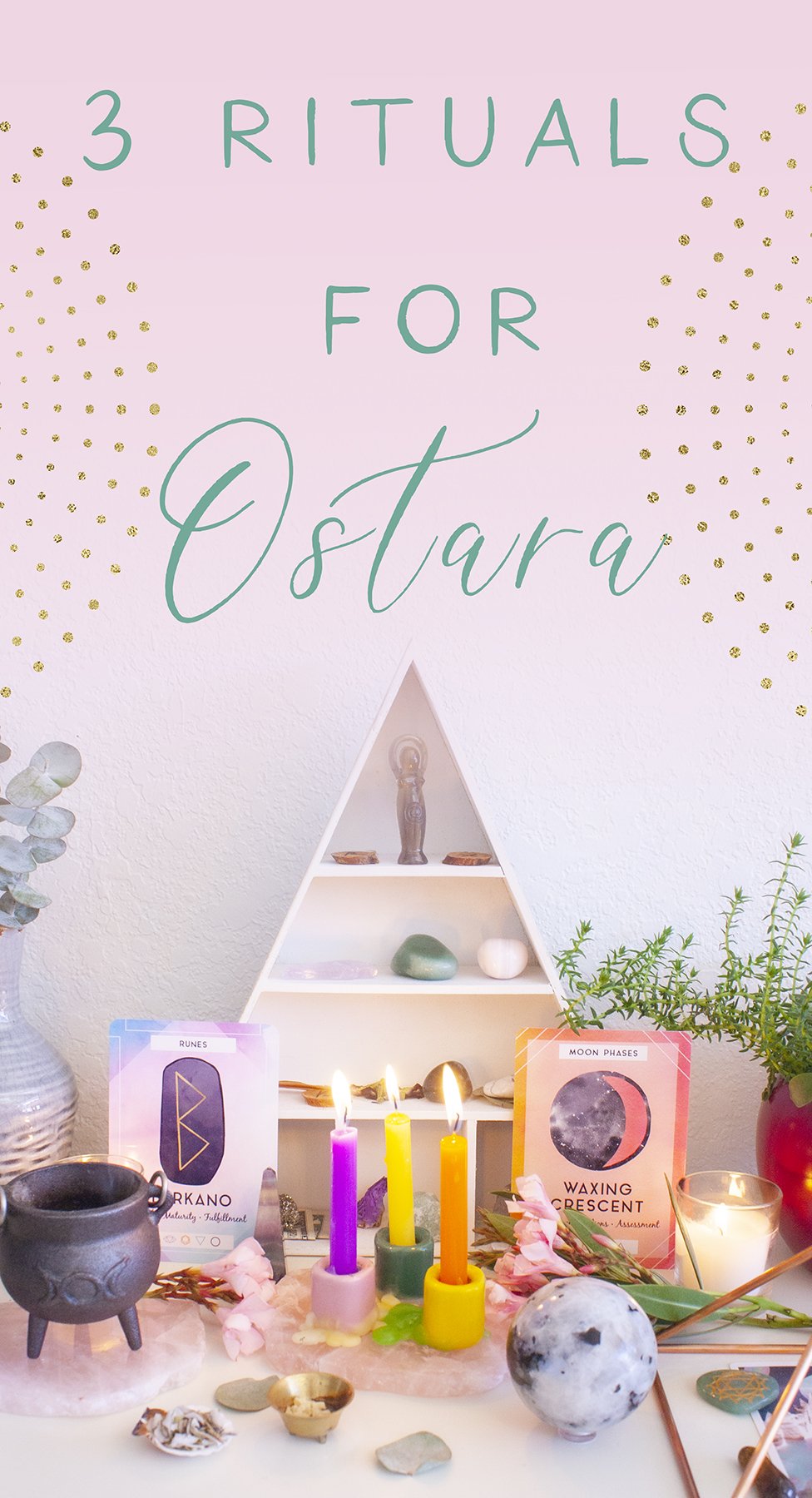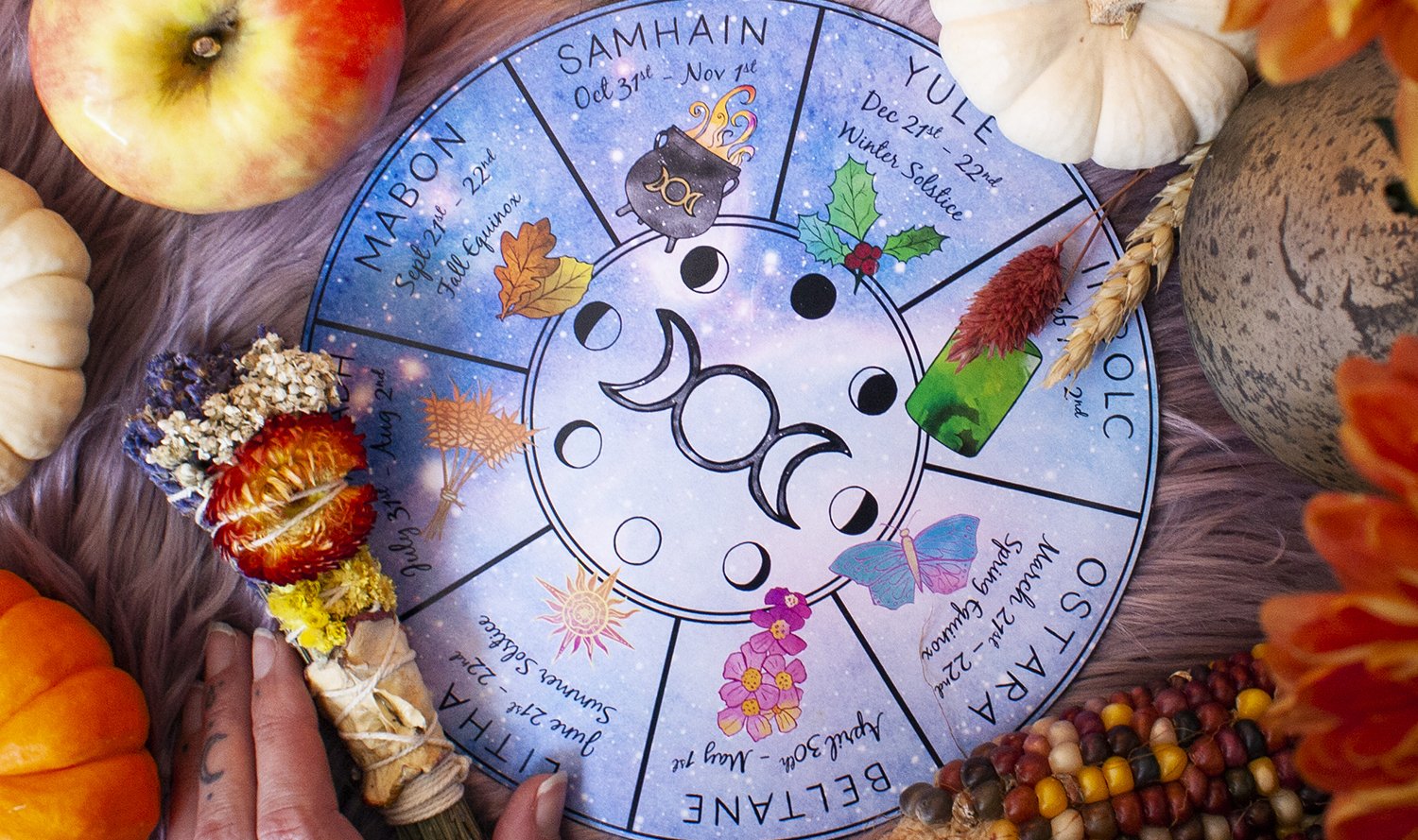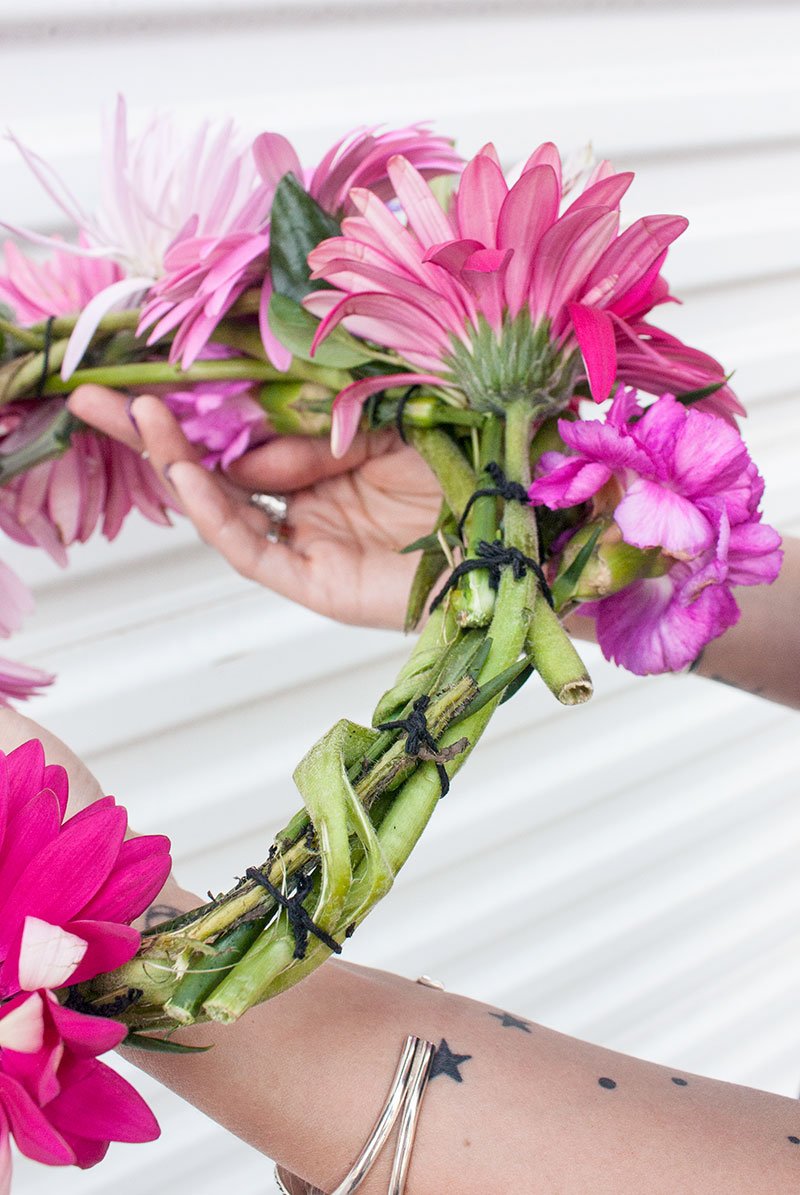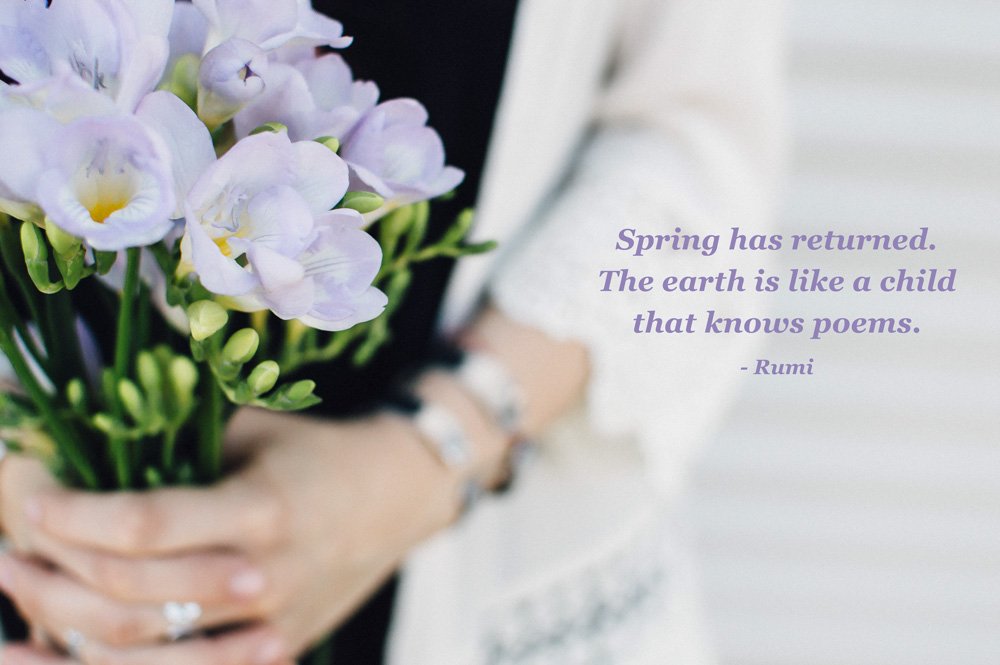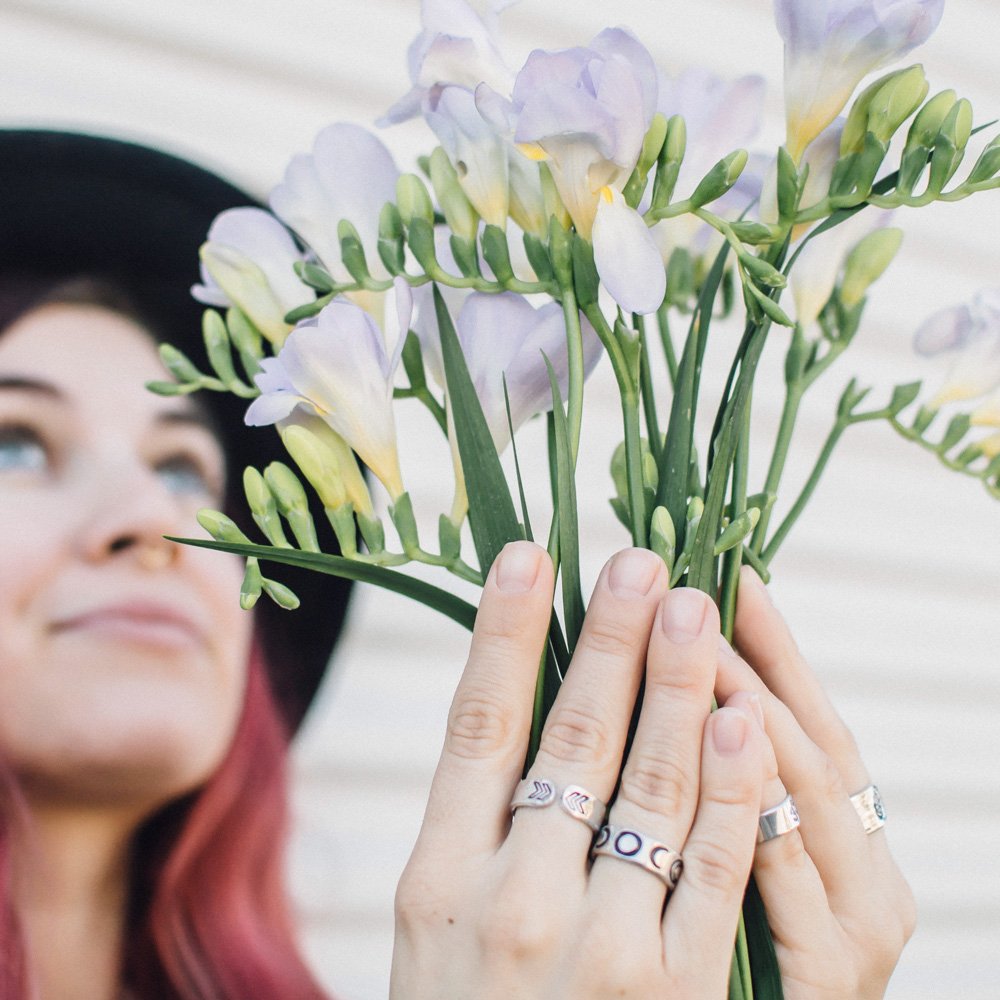Opening to the Wisdom of East, Air, and Springtime
The Spring Equinox shifts our seasonal wheel to the East, the home of the element of air, inspiration, and new beginnings. In this share, you'll learn all of the delicious correspondences for this season, the significance of the season, how to deepen your connection with this season, and why you'll want to. This is a continuation of a larger series of exploring the wheel by seasons.
The Spring Equinox shifts our seasonal wheel to the East, the home of the element of air, inspiration, and new beginnings.
In this share, you'll learn all of the delicious correspondences for this season, the significance of the season, how to deepen your connection with this season, and why you'll want to. This is a continuation of a larger series of exploring the wheel by seasons.
If any of it sounds foreign or new, I encourage you to go back to read or listen to the episode about the North here, where I dive a little deeper into sacred wheels and their uses across cultures.
Listen to this episode on my podcast here.
Every seasonal shift is an invitation to see the natural world as a mirror to our own lives and a call to notice how you are reflected in the natural world because you are the natural world. No matter how separate you may sometimes feel, you are nature. You are earth. Each shift is a call to remember this truth and attune yourself to these natural rhythms.
Do you ever feel like you want a roadmap for life? Living cyclically offers a map. A map that reminds you to allow for times of expansion and growth as well as times of rest and even death and destruction. The roadmap of living cyclically with the seasons may not always be fun and exciting, but that's because life isn't always fun and exciting. Life is fucking hard sometimes, and living cyclically normalizes that truth.
The season of Springtime, governed by the cardinal direction East, begins at the Spring Equinox and spans Beltaine until we reach Midsummer or the Summer Solstice. There are so many juicy things unfolding in this season. It's a season of action, play, and expansion! Let's explore the wisdom of the East and what this season has to offer.
Wisdom of the East
On the sacred wheel, we shift East as we shift to the Spring Equinox. This shift also brings the beginning of a new zodiac year with Aries season. An immense burst of energy happens as we move into this season, and it's often easy to see in the natural world. It's getting warmer, the days are getting longer, and plants are starting to wake up. The earth is fertile for new life, and so are you.
As a collective, oh, how we need some East energy! As I prepared this episode, something that stood out to me was the word humility. Being in a space of humility is very much associated with the East. There is action here, but there is also an openness and willingness to be open and allow new wisdom to permeate your being. It's a space that encourages us to be okay with not knowing. Humility seems to be something we've been missing deeply in our divided society. There's so much time and energy claiming to be the correct person with the only correct answer. I don't say this to point fingers; I certainly get caught up in it at times as well. This season reminds each of us that no one knows everything and to be open to new ideas.
You know what I love more than anything is when someone says, "I don't know." What a breath of fresh air. This is the home of the East, the humility to continue to be open to continue to learn. We are each given this opportunity during this season to honor the not-knowingness, to sit in it, and to be open to what gifts of wisdom may want to come through.
Air Element Card from The Ritual Deck
Just as the plants begin to form buds and burst forth with life, your inner world is fertile for new growth. On a personal level, this season encourages you to open yourself up to new paths and to begin taking action. Feelings of uncertainty are a natural part of taking steps towards building something new; the East reminds us of this, that part of beginning a new path requires a certain amount of trust.
You don't wake up knowing everything that will transpire throughout your day; there are always certain unknown or out-of-control elements. The East invites you to honor this and embark on your day regardless. The tree doesn't know that it won't be struck down by lightning or some other unforeseen force as new buds and leaves grow, but it grows anyway. The tree does not sit wondering how I will grow these leaves, even amidst all the pain in the world. Rather it tends to its needs, supports life around itself, and continues to grow. We can apply this same thinking to new endeavors. Even when the path ahead is scary and unknown, you can move forward with what you do have and trust that you will know how to address situations as they arise.
Here's a snippet from a book by one of my mentor's mentors called "Sacred Wheel of Our Ancestors" by Roberta Lee. I don't think it's in print anymore, and it's more like a pamphlet than a book, but you may be able to do some digging to find a used copy. In the chapter about the East, she says.
"It is in the East that we can call out and beg to know our paths. For this is the first step of many on this journey. However, be aware that while you search for your path, you're probably on it. If you cannot see it, it is likely that it is because you walk it. If you do see it, perhaps you are not there as yet. So take that step.
This is the place of surrender, of abandonment to the Great Mystery, of life itself. It is a commitment; certainly, a sense of risk accompanies us as we face the East. Dare to look into that sunrise, sense the warmth and healing of the sun as it begins its daily journey across our sky."
Sacred Wheel of Our Ancestors by Roberta Lee
East Correspondences
There are so many beautiful ways to connect with the energy of the east. Springtime itself is something that so many look forward to, so it's the ideal season to simply enjoy nature. If it doesn't yet feel like spring where you are, or you'd like to get in touch with the energy of the East in a different season, here are some ways to honor this season through corresponding energies or energies that match each other.
Moon Phase: Waxing crescent
Phase of life: Childhood / the Maiden
Themes: Play, joy, curiosity, fertility, growth, expansion
Color: Yellow
Element: Air
Time of Year: Springtime
Time of day: Dawn
Items and tools: Flowers, eggs, herbal smoke, feathers, fresh herbs, rabbits, and hares
Crystals: Kyanite, citrine, quartz
Tarot: Suit of swords
Ogham: Nuin/Ash and Huathe/Hawthorne
Air and East oracle cards from The Ritual Deck
Rituals to Connect with East
1. Honoring your inner child with play
Opening ourselves up to new ideas and wisdom can be hard. As we grow older, we tend to get more and more set in our ways for most of us. On a physiological level, our brains are less able to learn new things. It takes more of a conscious effort to open yourself up to learn new things. One of the secrets to being able to do this is allowing yourself to be open and receptive, and play is a powerful way to get into this receptive state of being.
We already know that young children learn through play. Why is that? Play forces us to be in the moment, which opens us to new ideas and ways of being. It allows us to temporarily let go of all of the things we feel we need to carry as an adult—the money, job, responsibilities, and so on. Play is an opportunity to distance ourselves from all of these storylines and be present in a different way. Play is unpredictable and therefore fosters experiences of new insights. It cracks us open in a way.
I'm fortunate to have two 3-year-olds in my life, so I'm frequently given opportunities to engage in play. Even with my two little busybodies, I still have to remind myself to let go of all the weights and stories I'm carrying and just be with them. Like everything, play can take some practice too.
The way you decide to engage with play, children or not, will be unique to you. I encourage you to take some quiet moments to reflect inward and ask yourself what would feel like a playful and freeing activity to engage in. It may be on your own, with your kids, or with a partner. Consider thinking about what your favorite playful activities were when you were young. There's no wrong way to do this and no desired outcomes. Your only goal is to allow yourself to be in the energy of play, whatever that looks like for you.
Here are some soft suggestions if you feel stuck.
Draw, paint, or color with no desired outcome
Cook or bake a new dish that excites you
Turn on some fun music and move your body
Make something with recycled materials
Learn a new song and sing it to a friend or some plants
Play a game solo, with family or friends
Explore a new area of your city
Draw, paint, or color with no desired outcome
Cook or bake a new dish that excites you
Turn on some fun music and move your body
Make something with recycled materials
Learn a new song and sing it to a friend or some plants
Play a game solo, with family or friends
Explore a new area of your city
Another way to honor your inner child is to bring healing to your inner child. So many of us carry wounds related to trauma that happened to us as young children. There are several ways to approach inner child healing, one way is therapy, but there’s also a lot you can do on your own. Personally, I found a lot of healing through EMDR therapy, but I’ve also approached my inner child healing from a spiritual perspective as well by journeying to parts of my childhood that needed healing.
If this is an approach you’d like to try I held a group guided journey for this that’s now available in the shop. Of course, you can do this on your own as well, but if you’d like some support there’s a workbook and recording to help guide you through it. Click here to explore it.
2. Connecting with the maiden of the Triple Goddess
We have the maiden, mother, and crone in our triplicity of Goddess archetypes. Each phase carries its own unique energies with both negative and positive attributes. The maiden aligns with the waxing crescent moon, steeped in exploratory and expansive energy. The maiden honors seek to expand, learn and grow in new ways. They do not shirk away from pleasure and rather lean into it.
You do not need to be a particular age to lean into this energy; it can be called upon at any time in your life regardless of age and gender. This season is an opportunity to notice your relationship with the maiden and lean into it. How do you feel when in the presence of someone who feels safe and empowered in their sexuality and pleasure? Does it make you feel uncomfortable, angry, or do you celebrate them? The way you respond or feel when presented with the energy of the maiden can be a big indication of what your relationship is like with yourself in this area.
Aphrodite card from The Goddess Oracle
There are many ways you can connect with the maiden energy. One way is to connect with maiden Goddesses. Every culture has maiden Goddesses, and I encourage you to explore Goddesses in line with your heritage. Here are some of my favorites that I often work with at this time.
Eostre is a Germanic and Norse Goddess of the Springtime. The first written history of Eostre did not come about until a Christian monk named Bede wrote about her in 725 AD. This doesn't mean she wasn't around before this, but we don't have any evidence that she was. Eostre embodies the energy of fertility and growth. She's strongly associated with eggs and hares, both symbols of fertility.
Freya and Frigg, a Norse Goddess (who some separate as two separate Goddesses) associated with pleasure, sexuality, and magic. Freya simply means lady, while Frigg comes from a root word for "beloved." We can even see Freya's connection with love and pleasure even today on our weekdays. Friday, the day of the week corresponding with love and romance, comes from the "day of Frigg."
Aphrodite and Ishtar are also associated with love and pleasure, which can be powerful to connect with or learn about at this time. Aphrodite is a Greek Goddess who many believe was modeled from the Middle Eastern Goddess of love, sexuality, and battle.
There are so many ways to connect with and honor different Goddesses at this time. Consider meditating or journeying to connect with them. You could set up an altar to honor and celebrate them or learn about them. If you're feeling overwhelmed with which Goddess to connect with, I encourage you to go within and open yourself up to connecting with a maiden Goddess to see who and what comes through. We all have connections to different deities through our heritage, and sometimes the best way to connect is by honoring your inherent wisdom.
If connecting with deities isn't in your practice, consider meditating during the waxing moon phase, exploring your sexuality, or working with magical tools that invoke a sense of pleasure and fertility to connect with the energy of the maiden.
3. Connecting with the element of air
The element associated with this season is air, so honoring and connecting with this element is a potent way to feel into this season. Air is such a unique element. Unlike the other elements, we can't see air. We can see its effects as it swirls about, but we cannot see air itself. This truth brings a unique energy to this element and how we connect with it.
The air element is an active and outward-facing force that sets things in motion. It is also clearing but not the same healing way that water is. Rather, it brushes aside things so that we may be permeated more deeply. Air aims to mix and swirl about our perceived realities so we can see things from a new perspective.
I think it's important to note that as we shift into Springtime and East on the wheel, we simultaneously move into the fire sign of Aries. We all know what happens with fire gets some extra air; it grows, it gets bigger. I see it as another beautiful expression of the power of this season.
When out of balance, air can push us towards overthinking, anxiety, and lack of focus. Air can be overwhelming. We can see this quite easily in the suit of swords in the tarot, which corresponds with the element of air. In many ways, the suit of swords is one of the more feared suits. There's so much pain and mental anguish present on the cards.
It's as powerful as a sword when you learn to engage with air in a more controlled way. Wielding the force of air allows you to cut through perceived realities and see new pathways. Air is the gracious idea bringer, and your job is to discern what's for you and what isn't. Air gives you the voice to say what needs to be said with truth and compassion. Air, though invisible, has the power to knock over buildings or subtle enough to blow out a candle.
A powerful exercise to cozy up with the element of air and the tarot is to spend some time with the queen and king of swords. Notice how they appear so sovereign in their ability to control their chosen tool. This tool goes for any of the elements. The Kings and Queens of the suits show us what each element looks and feels like in its most exalted form.
Beyond the tarot, I love experiencing the element of the air outside. Notice how the air feels against your skin, what it stirs within you, and how it makes you feel. I start so many days looking outside and noticing how the trees are moving from the air. I use it as a form of divination, a little nudge to be more still or to get busy. I've received so many messages from my "tree friends" by way of how the air moves them. I love visualizing the air clearing away blocks and stuck energy so that I may see and know more clearly.
With spring upon us, I hope you can find time to be outside amidst the air, to feel it blow through your hair and over your body. I hope you can allow it to push aside any stories you need a break from so you can see things from new and playful perspectives. I hope you can honor your inner child and the maiden within you, calling out for play and pleasure.
Egg History & Rituals for Ostara + The Spring Equinox
Ostara, also known as the Spring or Vernal Equinox, is the dawn of the fertile season on the Wheel of the Year. Light and dark are in equal balance and moving forward, the light of the sun will outshine the dark of night, pushing nature into a flurry of growth and expansion. This season corresponds to growth, fertility, manifesting, and the maiden aspect of the Triple Goddess.
Ostara, also known as the Spring or Vernal Equinox, is the dawn of the fertile season on the Wheel of the Year. Light and dark are in equal balance and moving forward, the light of the sun will outshine the dark of night, pushing nature into a flurry of growth and expansion.
This season corresponds to growth, fertility, manifesting, and the maiden aspect of the Triple Goddess. The energy of this season calls you to begin taking concerted actions towards your desires. Eggs and hares are common symbols associated with this season, but their associations may not be as ancient as you thought.
I went down a bit of a rabbit hole, no pun intended, on this one! So, before we dive into egg rituals for you to practice, I want to share a bit about the history (we do know) of Ostara. If you don’t care, skip on through to the egg rituals, but personally, I find the history of our rituals not only interesting but important in crafting a meaningful practice.
Eggs and Ostara, Where’s the Connection?
There are a couple of stories that link Ostara to eggs and hares. One being that a hare out foraging for food found an egg and gave it to Ostara an offering for Spring (read a more elaborate version of this story here.) The other story speaks of Ostara finding a bird with frozen wings that she turned into a hare to save. The hare retaining its ability to lay eggs, laid an egg for Ostara as a show of gratitude. You can find variations of stories passed down similar to these or possibly have some in your lineage.
As with much of Pagan and spiritual practices from the Celts and Anglo-Saxons, these traditions were passed down orally. However, there’s actually no written pre-Christian evidence of the Goddess Ostara and her connection to hares and eggs. Ostara is first mentioned in a text by a Christian monk named Bede in 725 AD.
This isn’t to say that it’s not possible that ancient Northern European folks honored hares, eggs, and maiden Goddesses like Ostara and Freya during this season. Still, there’s no written evidence supporting these stories. Here’s a great article that dives deeper into the history we know about Ostara and her connection to eggs and hares.
Card feature from the Goddess Oracle by Amy Sophia Marashinsky.
When Christianity dominated these areas, the oral traditions were slowly extinguished, as well as many of the ancient practices associated with them. So the truth is, we may never know if Ostara and her connection to hares and eggs were real. You can view this as a hardship or an opportunity. I choose the latter. Not having a script for our ancestors' ancient ways offers you an opportunity to go within and form personal meaning with each season.
Give this post a listen here:
Symbolism of Eggs
Regardless of how the connection of eggs came to be associated with Ostara and this season, their connection to fertility, life, and union is found worldwide. Vedic texts reference the cosmic egg, the Orphic egg in Greece, and the Serpent’s Egg in Druidic practices, just to name a few, all of which deal with the beginnings of life and fertility.
Many of the ancient mythologies surrounding eggs tell stories of life, balance, and creation, which are all energies undoubtedly linked to the energy of the Spring Equinox. For these reasons, regardless of the history of eggs and Ostara, the egg is still a beautiful and potent symbol to work with during this season, or really anytime you’re focusing on fertility and growth.
Egg Rituals for Ostara
Here are a few simple ways to weave eggs into your Spring Equinox rituals. Vegan? No worries, use fake eggs. As with most magical practices, your intention is the most important part. Working with fake egg-shaped decorations is an ideal substitute for the real deal. You can purchase egg shapes in paper, plastic, and wood at most craft stores. For the rituals shown below, biodegradable eggs made from paper or wood are best. Please, don’t bury plastic eggs!
Eat them!: Obviously, if you’re vegan, you can skip over this one. But if you’re not, enjoy eggs in your favorite way or bake with them to connect with their energy of creation. Consider holding the egg in your hand and infusing it with your desires that you’d like to manifest over the coming months.
Decorate: Place plain or decorated eggs on your altar or in your home as a symbol of fertility, balance, and growth. If you’re using real eggs, you can blow out the contents of the egg with a needle and a straw; otherwise, fake eggs will work fine as well (raw eggs shouldn’t be used if left out for more than two hours.)
Egg manifesting ritual: Write wishes, draw Runes or a Sigil on an egg (raw, hard-boiled, or a fake egg) in alignment with your desires. Bury your egg in the ground to let the fertile energy of the earth help it manifest. Amplify this ritual by burying your egg alongside some seeds. As your plants grow, they will serve as a reminder of your desires being manifested.
Egg offering: Hard boil one or more eggs and leave them as an offering out in nature to give thanks for the season's fertility and growth.
Now you can work with eggs this season and have a better idea of what we do know about their history in regards to Ostara. Remember, even though we don’t have written history, it doesn’t mean that Ostara wasn’t honored. In the end, this season is a time to work with the energy of fertility and growth, and if honoring Ostara, the hare, and eggs is a way that helps you do that, I encourage you to do so! Continue creating a practice that’s meaningful to you.
Check out our past blog posts about Ostara here.
Three Rituals for Ostara
The spring equinox, also called Ostara, takes place around March 20th each year. This sabbat marks the day when dark and light are in equal balance. After Ostara, we have more light each day and less darkness as we build up to the peak of the sun at the summer solstice. These rituals are great to perform anytime between the Ostara and Beltane.
The spring equinox, also called Ostara, takes place around March 20th each year. This sabbat marks the day when dark and light are in equal balance. After Ostara, we have more light each day and less darkness as we build up to the peak of the sun at the summer solstice. These rituals are great to perform anytime between the Ostara and Beltane.
The Earth is beginning to get warmer and more fertile each day. Associated with the maiden aspect of the triple goddess, Ostara is a time of new life, fertility, balance and harmony, birth, manifestation, and innocent, child-like wonder.
In this post, I’ll be sharing 3 rituals for Ostara. Keep scrolling for all three rituals and check out the video below.
CREATE AN OSTARA ALTAR
Creating an altar is a beautiful way to honor any nature-based holiday. I’m a huge fan of letting altar creation be intuitive - what does Ostara mean to you, and what symbols can you place on your altar to represent that personal meaning? Learn more about altars here.
With that being said, here are some altar item suggestions to inspire your creativity:
Fresh flowers
Eggs
Pastel-colored candles
Fertility goddess drawings or photos (remember, fertility isn’t just about birthing babies but about the energy of creation - which we can channel into so many different creations!)
A photo of your child self
Sprouts
Images of rabbits
The Sun card, Lovers card, or other tarot cards you associate with this time
Crystals associated with fertility, renewal, or balance like sunstone, green aventurine, moss agate, or peach moonstone
You can ritualize your altar creation by gathering your items mindfully and taking some time to meditate before putting your altar together. As you place each item on your altar, feel the energy of Ostara moving through your body and your space, bringing you renewal, fertility, and harmony.
CHILDLIKE WONDER RITUAL
One of my favorite rituals for Ostara is simply doing an activity you loved as a child. Maybe you loved to play in the forest, paint with your hands, swim in the ocean, or sing. Carve out intentional time to do that activity again today, and notice how your inner child responds. My guess is that she’ll love it!
As you play, see if you can suspend any skeptical or critical voices that may pop up inside, saying that what you’re doing is silly or stupid or doesn’t matter. Can you access the sense of pure wonder, curiosity, and play you once felt every day?
Spend some time journaling afterward to process your experience and dig into the ways you’d like to bring more childlike wonder into your daily life.
BALANCE RITUAL
For this ritual, you’ll need:
2 spell candles of different colors
Moss agate (optional)
This ritual connects to the balance aspect of this holiday. Remember, on any equinox (spring or fall), light and darkness come into balance. It’s a powerful time to find more balance in our lives, too.
Start by grounding yourself with a few deep breaths or using another grounding practice you enjoy. Take some time to get clear on where you need more balance in your life. If you’re using moss agate, a naturally balancing crystal, you could hold it at this time. You might like to meditate, do breathwork, free write, or pull cards to get clarity on the balance your heart is craving.
Once you feel clear, take a few deep breaths to return to center and speak aloud where you are craving more balance in your life. Light your candles as you say, “As I light these candles, I call in more balance between ______.”
As your candles burn, visualize yourself having this balance in your life. How does it feel? Who do you become? Really take your time to luxuriate in this energy as you let your candles burn all the way down.
Take a moment to ground yourself again, and close your ritual with a moment of gratitude.
Which ritual will you be doing for Ostara? We’d love to hear on Instagram! You can find more rituals for Ostara here and meditations for the Wheel of the Year here.
What is the Wheel of the Year?
Learning more about the Wheel of the year will not only help you feel more in-tune with nature, but it will give you rituals to use year-round to connect with yourself and Mother Earth. This topic can seem a little overwhelming when getting started, so I will provide you with a quick overview with this post. I'll cover what the Wheel of the Year is, who uses it, how to use it, and some resources, including a free printable of a wheel that I created.
Learning more about the Wheel of the year will not only help you feel more in-tune with nature, but it will give you rituals to use year-round to connect with yourself and Mother Earth. This topic can seem a little overwhelming when getting started, so I will provide you with a quick overview with this post. I'll cover what the Wheel of the Year is, who uses it, how to use it, and some resources, including a free printable of a wheel that I created. Keep scrolling to read more and find a link to your free copy.
What is the Wheel of the year?
The Wheel of the year is comprised of eight Sabbats or festivals that occur on or around the same day each year. The eight Sabbats include four solar events, i.e., the Summer Solstice, Winter Solstice, Spring Equinox, and Fall Equinox. The remaining four festivals are based on seasonal changes and farming. Here's a rundown of the eight Sabbats, what they align with, and their dates:
Samhain: October 31st - November 1st // Samhain is considered the witch's New Year. It is the third and final harvest season and ends the seasonal Wheel.
The Winter Solstice & Yule: December 21st or 22nd // Winter Solstice
Imbolc: February 1st // Holiday is known as Candlemas, which signifies the first signs of Spring
The Spring Equinox & Ostara: March 20th // Spring Equinox (first day of Spring)
Beltane: April 30th - May 1st // A fire ceremony that signifies the midpoint between Spring and Summer
The Summer Solstice & Litha: June 21st or 22nd // Summer Solstice
Lughnasadh: July 31st - August 1st // Marks the first harvest of the year
The Autumn Equinox & Mabon: September 21st - September 23rd // Fall Equinox
© Cassie Uhl 2015-2025. Please properly credit when sharing.
Who Celebrates the Wheel of the Year?
You don't have to subscribe to a specific religion or label to use or observe the Wheel of the year. Most notably, Wiccans, Pagans, Neo-Pagans, and practicing witches reference the Wheel of the Year for festivals and rituals. If you don't identify with any of these labels, but like to dabble in ritual or spellwork, that's perfectly fine! You'll still be able to find many uses for this powerful tool.
Where did the Wheel originate?
The Wheel of the year is rooted in several cultures and combines festivals from Romans, ancient Greeks, Germanic cultures of northern Europe, and the Celts. It's for this reason that you'll see a variety of names for some of the festivals and differing dates. For example, Lughnasadh also goes by Lammas or Lughnasa, and Litha also goes by Midsummer.
The full Wheel of eight festivals is a relatively new creation that came about in the 1950s. The groups listed above each celebrated some of the eight Sabbats, but the evidence is lacking that any of them celebrated all eight. Combining all eight into a wheel was a way to honor and streamline all of the celebrations that many Pagans and Wiccans hold dear.
How to Celebrate The Wheel of The Year
Learning to implement the Wheel of the Year can feel overwhelming, but the way that you work with it can be as simple or complex as you want it to be. There are countless ways to celebrate each celebration on the Wheel of the Year. Check out the list below for a general list of ways you can enjoy the Wheel of the Year. For specific rituals and celebration suggestions, check out The Goddess Discovery Book V2 or search our blog for the Sabbat you'd like to learn more about.
Spend time outside in nature.
Attend a local celebration or create your own for some or all festivals.
Conduct a ritual for each Sabbat. You can find several ritual examples for each Sabbat by searching the Sabbat on our blog.
Add decor and scents to your house based on the Wheel of the Year.
Cleanse and update your altar or sacred space for each Sabbat.
Cook specific foods for each of the Sabbats.
Enjoy crafts with your Goddess circle or kiddos based around the Sabbats.
Go within and try journaling for each Sabbat.
Perform a unique tarot or oracle card spread.
Here's an example of how I often perform my altar update for a new Sabbat.
Additional Resources
Want to dig deeper into using the Wheel of the Year in your practice? Here are three ways to learn more:
1. Click here for my wheel of the year graphic in my magical printables bundle.
2. Click here to purchase Understanding The Wheel of The Year, which goes into detail about the Wheel of the Year and contains wheel images for both the Northern and Southern hemispheres, rituals, card spreads and journal prompts for each Sabbat.
3. Find links to blog posts specifically for each Sabbat below.
Here are other books that I love about the Wheel of the Year: The Magical Year by Danu Forest, The Great Work by Tiffany Lizac, and The Modern Witchcraft Guide to the Wheel of the Year by Judy Ann Nock.
I hope you find the Wheel of the year as special and magical as I do! It has so many positive and powerful applications to bring life to your sacred practices.
Create a Flower Crown for the Goddess in You!
Breathe it in, do you smell it? Spring is here! Sending you joyous Spring Equinox and Ostara vibes! Ostara is the Wiccan holiday that honors the Spring Equinox and its part of the Wheel of the Year. Ostara is a time to bring balance to your life, welcome the coming light, and celebrate blossoming life.If you are looking to bring some sunshine into your world after hibernating for the past few months, wearing a flower crown will really get you in the springtime spirit and give you good reason to embrace your goddess energy.
Breathe it in, do you smell it? Spring is here! Sending you joyous Spring Equinox and Ostara vibes! Ostara is the Wiccan holiday that honors the Spring Equinox and its part of the Wheel of the Year. Ostara is a time to bring balance to your life, welcome the coming light, and celebrate blossoming life.
If you are looking to bring some sunshine into your world after hibernating for the past few months, wearing a flower crown will really get you in the springtime spirit and give you good reason to embrace your goddess energy.
Crowns of all sorts have adorned the heads of the most ultimate goddesses throughout time and across cultures. However, no crown seems to come close to the beauty that is the flower crown, and it’s the perfect celebratory craft for Ostara.
I’ve got a bit of floral history for you, the meaning behind some favorite flowers, and a short DIY to get you started with flower crowns.
History
Wicca
Floral crowns have been used for celebrating Ostara (Spring Equinox) and, maybe more commonly, Beltane (the celebration between spring and summer). Various Pagan religions would adore statues of their Gods and Goddesses with flower crowns during these times of the year.
Flora
The Romans held this fertility goddess in high esteem. Flora was said to wear “garlands of a thousand flowers.” In the Roman culture, a springtime festival was held to honor the renewal of the lifecycle. If flower crowns are your thing, then this was the place for you! Even the dogs were decorated with flowers! Flora was said to wear soft yellow flowers to represent the essence of spring. Honor Flora with a buttercup blossom!
Island Life
Hawaii definitely has its bases covered when it comes to tropical blossoms. Here, flowers are worn on ankles, wrists, and yes...heads, too. In Hawaii floral crowns are known as “haku lei.” You can find bronzed goddesses roaming the beaches decked out in flower crowns on any day of the week! It's also customary for the natives to gift these beautiful crowns to friends and visitors.

Flower Meanings
Laurel: Symbol of triumph
Buttercup: Childishness, neatness, humility
Myrtle: Marital fidelity, good fortune
Periwinkle: Happy memories, achieving your dreams
Daisy: Innocence, cheerfulness
Rose: Love
Pink Peony: Riches, honor, prosperity
Baby's Breath: Long lasting love, angelic
Dandelion: Survival, spiritual intelligence
Gardenia: Purity, love
Laurel: Success, glory
Daffodil: Self love
DIY Flower Crown
Crown crafting is the perfect tribe building activity! Of course, you're economical so it only makes sense for you and your besties to get together and bring your favorite bunch of flowers to share.
I really wanted to create my flower crown with only flowers. Turns out, that is pretty tough. I was able to create my crown from flowers plus a little string.
If you’re using thinner, bendier stems, I think it would be possible to create a crown from only flowers. If you’re going for a statement-making crown like mine, string might be a necessity.
Supplies: Flowers, scissors, string
Start with three flowers and start by braiding the stems together.
As you braid continue to add in more flowers and their stems into your braid.
Once you have long enough braid of flowers to make a crown, carefully bend your braid into a circle shape.
Using string or a stem of a flower tie the back overlapping parts of your flower braid.
Fill out your crown by sticking flowers into the braid around the crown or by tying them onto the braid.
This took some time and patience. I couldn’t be happier with my end result and I felt like a goddess all day! Be bold, rock your flower crown as you welcome Ostara, the coming light, and the birth of spring. You are the peaceful warrior, a goddess, the light bringer, and the bearer of sunshine!
2 Spring Equinox Rituals to Cleanse & Refresh
Have you ever been curious about how to celebrate the Spring Equinox, also called Ostara in the wheel of the year, or ever wondered what it is exactly? We’ve got explanations and two different ways that you can celebrate rituals for the Spring Equinox.The coming of Spring is marked by the Equinox - meaning “equal light.”
Have you ever been curious about how to celebrate the Spring Equinox, also called Ostara in the wheel of the year, or ever wondered what it is exactly? We’ve got explanations and two different ways that you can celebrate rituals for the Spring Equinox.The coming of Spring is marked by the Equinox - meaning “equal light.” The Spring Equinox, or the first day of Spring, occurs when the sun crosses the celestial equator from South to North. This special event happens every year on March 19th, 20th, or 21st. This year it is happening on March 20th. During this time, daylight and night are equal and balanced, right before tipping over to the side of light. Flowers are blooming, bees are buzzing, and birds are chirping…it’s officially SPRING!!Around the world, many different cultures hold celebrations for the Spring Equinox, and I want to share with you some of my personal favorites.
Yoga Mala Sun Salutations
More than a beaded bracelet, a yoga Mala is completed by doing a set of 108 sun salutations. It’s a great way to cleanse the mind, body, and spirit. Completing this could take as long as two hours (expect a lot of jump backs into Chaturanga), but you can always rest in downward facing dog or child’s pose. Sweaty as you may be, it’s a great way to cleanse and detoxify the body for a new season.
How to Get Involved
If you’re an experienced yoga practitioner you can set a time special time and place to do this on your own or with friends. If you’ve got a favorite local studio it’s likely that they’ll be offering something for Spring.
What to Know Before You Go
Sign up ahead of time for this special event at your local studio.
Come to class with an intention. An encouraging message will help you to push through.
Be prepared to sweat! The room will naturally heat from all of the movement and breathwork of you and your fellow yogis. Bring a towel to place over your mat, or a hand towel to wipe off any excess moisture that might cause you to slip.
Wear an inspirational piece of jewelry. I wear a hamsa hand around my neck that inevitably dangles in my face while I’m resting in downward facing dog reminding me “you’ve got this!”
Forest Bathing
Forest bathing is a Japanese tradition called “Shinrin-yoku,” or “taking in the forest atmosphere.” Unlike the vigor of a Mala, forest bathing is meant to be a calm, low-speed experience. As leaves begin to bud, and flowers begin to bloom, a forest bath is a perfect way to honor the arrival of Spring. You could do this by meditating in a lush green area, taking a hike, or even having a picnic.Not only are these ideas relaxing from a spiritual perspective, but there are actually scientific advantages behind these inspiring practices, too. Many trees give off organic compounds that decrease stress hormones and boost your immune system.
Additional Benefits Include:
Decrease in anxiety, depression, and anger
Increased cognitive function
Reduced blood pressure
Accelerated healing
Increased ability to focus
More energy and better sleep
Let me know if you’ve tried any of these in the past or have plans to create a new ritual this year. Happy Spring Equinox! Find more rituals for Ostara here.
